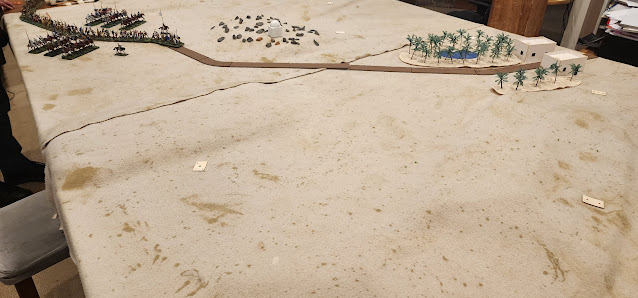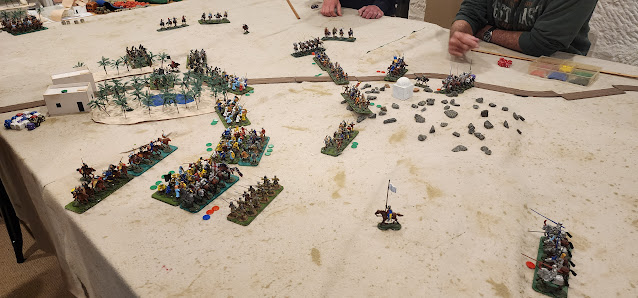Crusaders: Mark & Mike.
Saracens: Jim, Steve & Chris.
The Saracen players have placed playing cards next to each brigade on trays off table corresponding to cards on the table.
As the Crusaders deploy either side of the rocky ridge horse archers com eove rthe ridges to begin harassing them.When the Crusaders breast the ridges they find Saracen heavy cavalry on both flanks behind the horse archers & infantry near the oasis. On the near flank the Saracen heavy cavalry are putting up a good fight against more heavily armoured enemy cavalry.
On the far flank, the horse archer shave been more effective in assisting the heavy cavalry, but the Crusader infantry have attacked in support of their cavalry. On the near flank the Crusaders have won the cavalry fight, but not without severe casualties.
On the far flank, the Egyptian infantry advanced out of the village to support their cavalry & the Crusader attack on that flank has run out of steam.
At this stage it looks like the Saracens are winning.On the far flank the Crusaders have pulled back to regroup.
On the near flank the Crusaders have attacked the Arab foot with their last serviceable cavalry & spearmen while their archers rain arrows on the Arab centre.The Crusader charges on their left flank broke though & at the same time the archers destroyed the Saracen centre. In one turn the Saracens lost 3 Arab infantry units & failed their army morale test, so were forced to withdraw giving the Crusaders a victory.
Despite the Saracens having a a great run of the dice thru most of the game, one turn of good luck was all it took for the Crusaders to win. The post battle discussion brought up four possible explanations:
1. The Crusaders had a better strategy.
2. The points system over-valued the Saracen army. so the armies were unequal.
3. The scenario was tough for the Saracens
4. Luck on that the Crusaders didn't have a lot of it, but they got it the right time.
The Saracens strategy of weakening the enemy with horse archers, blunting the attack with their heavy cavalry, then holding on with their foot didn't work. In the first wave of combats, the Saracens stopped the Crusader cavalry, but in the process they lost almost all their cavalry broken while the Crusaders had a lot of units shaken but few broken. Only broken units count in the army morale test, not shaken ones, so when the Crusaders pulled back their weak flank to cut their losses there & renewed their attack with their few remaining unshaken units on the other flank, just three good combat results against the Arab infantry was all it took for the Saracens to have half their formed units broken & fail army morale.
My conclusion is that the critical factor in this battle was the Crusader's tactics of pulling back the flank where they were losing & reinforcing success. The better command ratings of the Crusader troops made it easier for the Crusaders to control the action. Perhaps the points system doesn't give sufficient weight to the difference in command ratings.







No comments:
Post a Comment